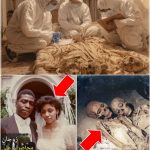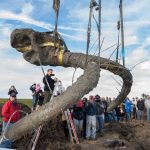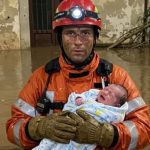“Mom, this is Welles. I want you to know that I’m okay.”
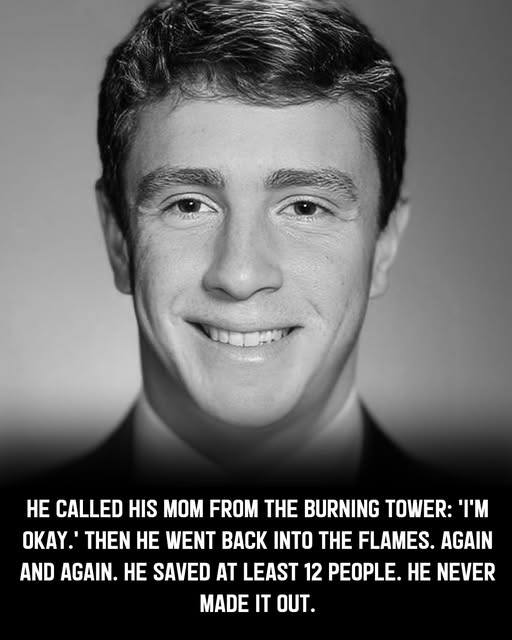
“Mom, this is Welles. I want you to know that I’m okay.”
It was 9:12 AM on September 11, 2001. Welles Crowther was on the 104th floor of the South Tower when American Airlines Flight 175 struck eighteen floors below.
The building shook violently. Walls cracked. Windows shattered. Smoke began pouring upward.
Welles Crowther was 24 years old. An equities trader at Sandler O’Neill & Partners. A former lacrosse player. A college graduate with his whole life ahead of him.

He could have run. He could have focused only on getting himself out.
Instead, he called his mother.
“Mom, this is Welles. I want you to know that I’m okay.”
And then he hung up and did something extraordinary.
He tied a red bandana around his nose and mouth—the same kind of bandana his father had given him as a child, the one he carried everywhere—and he ran toward the danger.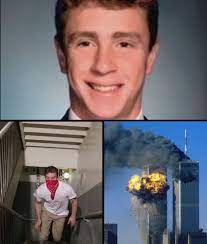

Welles made it down to the 78th-floor sky lobby, a transfer point between elevator banks. It was chaos. The plane had hit just below, and the floor was engulfed in smoke, flames, and falling debris. Injured people lay scattered. Others wandered in shock, disoriented, bleeding, unable to breathe.
And then they heard a voice. Calm. Steady. Authoritative.
“Everyone who can stand, stand now. If you can help others, do it.”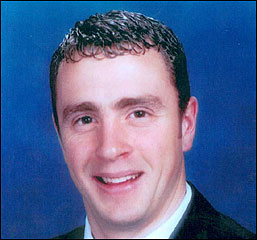

It was Welles Crowther. Wearing a red bandana. Taking charge.
Ling Young, severely burned and struggling to breathe, later described him: “He said, ‘Follow me. I know the way out.’ He wasn’t panicking. He was so calm.”
Welles led a group of survivors to Stairwell A—one of the few passable routes down. He directed them, encouraged them, helped the injured.
And then, instead of leaving with them, he went back.
Back into the smoke. Back into the fire. Back to the 78th floor where more people were trapped.
He found another group. He carried a woman on his back down seventeen flights of stairs. He told others to follow him. He gave them hope when they had none.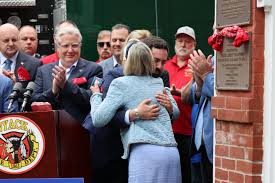

And then he went back again.
Survivors later recalled the man in the red bandana with awe. He wasn’t a firefighter—though he had been a volunteer firefighter in his teens. He wasn’t wearing any official uniform. He was just a young man in a suit with a red bandana, moving through hell like it was his job to save everyone.
Judy Wein, another survivor, remembers him carrying people, directing traffic, putting out small fires with a fire extinguisher. “He saved my life,” she said. “I don’t know his name, but I’ll never forget him.”
Welles made at least three trips back to the 78th floor. Maybe more.
He is believed to have saved at least twelve people. Possibly more who were never identified.
At some point, Welles encountered a group of firefighters heading up the stairs with rescue equipment. He joined them.
He was last seen heading up—not down—carrying a fire extinguisher and a woman over his shoulder.
At 9:59 AM, the South Tower collapsed.
Welles Crowther never made it out.
For months, his family didn’t know what happened to him. They knew he’d been in the building. They knew he’d called his mother. But they didn’t know how he died.
Then, slowly, survivors began telling their stories.

A man in a red bandana. Calm. Strong. Fearless.
Ling Young saw his picture in a news article about missing victims. She gasped. “That’s him. That’s the man who saved me.”
Other survivors came forward. Judy Wein. A man named Jeff Coombs. All of them remembered the red bandana.
Welles Crowther’s body was found in March 2002, in the rubble of the South Tower lobby, alongside firefighters and emergency workers. He had been with them, carrying equipment, heading back up to save more people.
He died doing what he was born to do: running toward danger to help others.
Welles had been a volunteer firefighter as a teenager in Nyack, New York. His father had been a firefighter. Welles grew up idolizing them, learning from them, wanting to be like them.
Even when he went to college and became a trader on Wall Street, he never stopped carrying that red bandana his father gave him. It was his good luck charm. His reminder of who he was.
And on September 11, 2001, it became his symbol.
After his death, Welles Crowther was posthumously named an honorary New York City firefighter. His red bandana was placed in the 9/11 Memorial Museum. His story was told in documentaries, books, and tributes.
Boston College, his alma mater, retired his lacrosse jersey and created the Red Bandana Run in his honor—an annual event that raises money for charitable causes.
His mother, Alison Crowther, has spent the past two decades telling his story to schools, fire departments, and anyone who will listen. Not to glorify him. But to remind people what courage looks like.
“Welles wasn’t a superhero,” she says. “He was just a young man who chose to help. And that’s something anyone can do.”
The survivors he saved went on to live full lives. They had children. Grandchildren. Careers. Weddings. Birthdays. Moments Welles will never have.
But they’re alive because of him.
Ling Young named her daughter after him. Judy Wein speaks about him at every 9/11 memorial event. Jeff Coombs tells his children about the man in the red bandana who saved their father’s life.
Welles Crowther was 24 years old. He had his whole life ahead of him. He could have escaped.
But he didn’t.
He called his mom to say he was okay. And then he made sure twelve other people would be okay too.
He didn’t wear a badge. He didn’t have special training. He just had a red bandana, a firefighter’s heart, and the belief that helping others mattered more than saving himself.
On September 11, 2001, 2,977 people died.
Welles Crowther was one of them.
But because of him, at least twelve people weren’t.
“Mom, this is Welles. I want you to know that I’m okay.”
He was okay. Because even in the face of unimaginable horror, he chose compassion over fear. He chose action over escape.
He chose to be the man in the red bandana.
And because of that choice, twelve families still have their loved ones.
Courage isn’t the absence of fear. It’s the decision to act despite it.
Welles Crowther made that decision. Again and again.
Until he couldn’t anymore.
Never forget the man in the red bandana.

